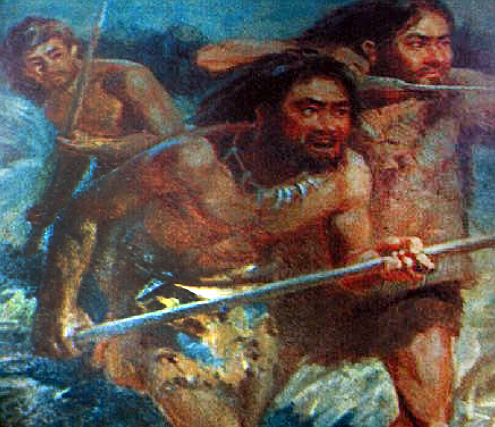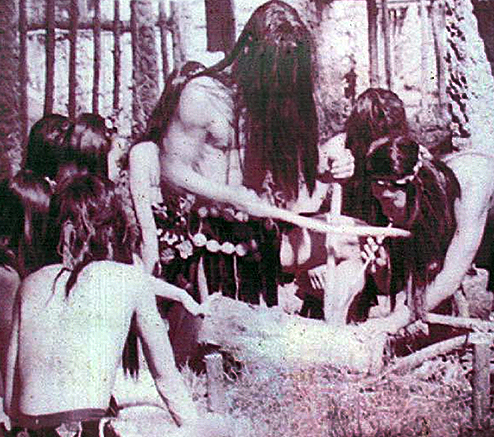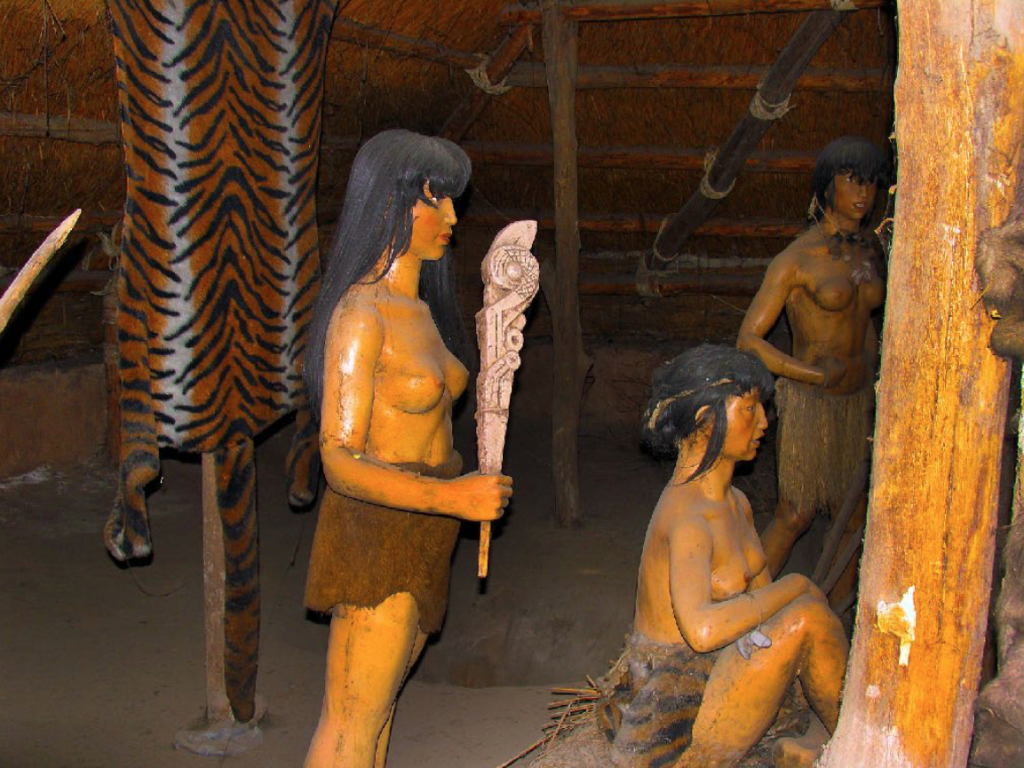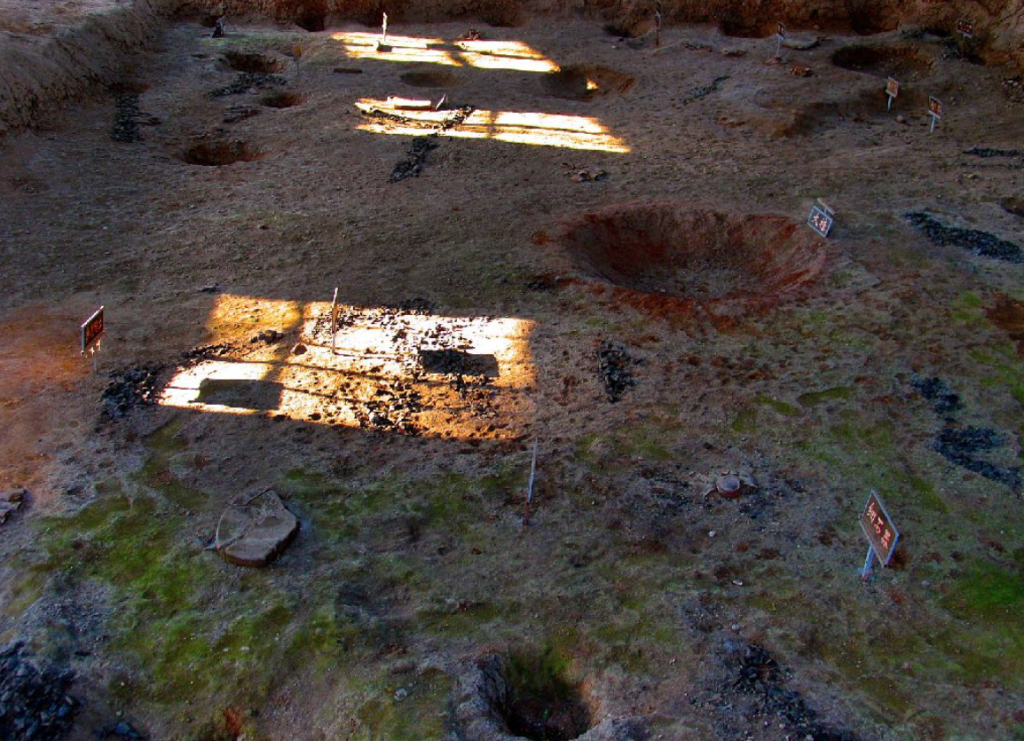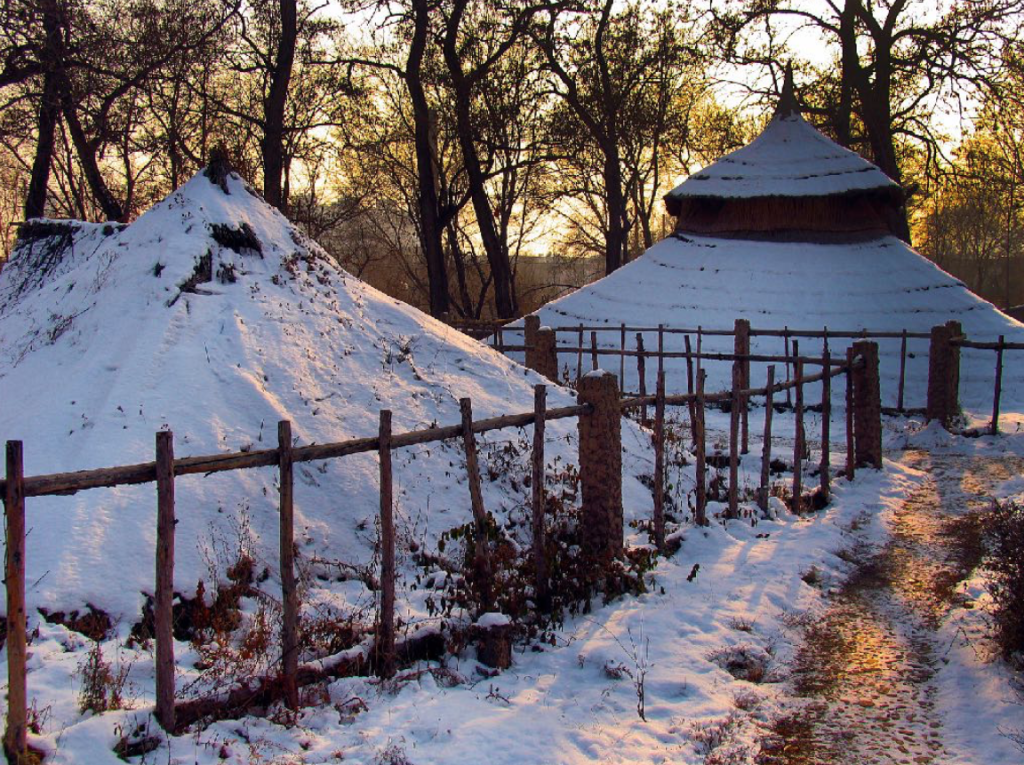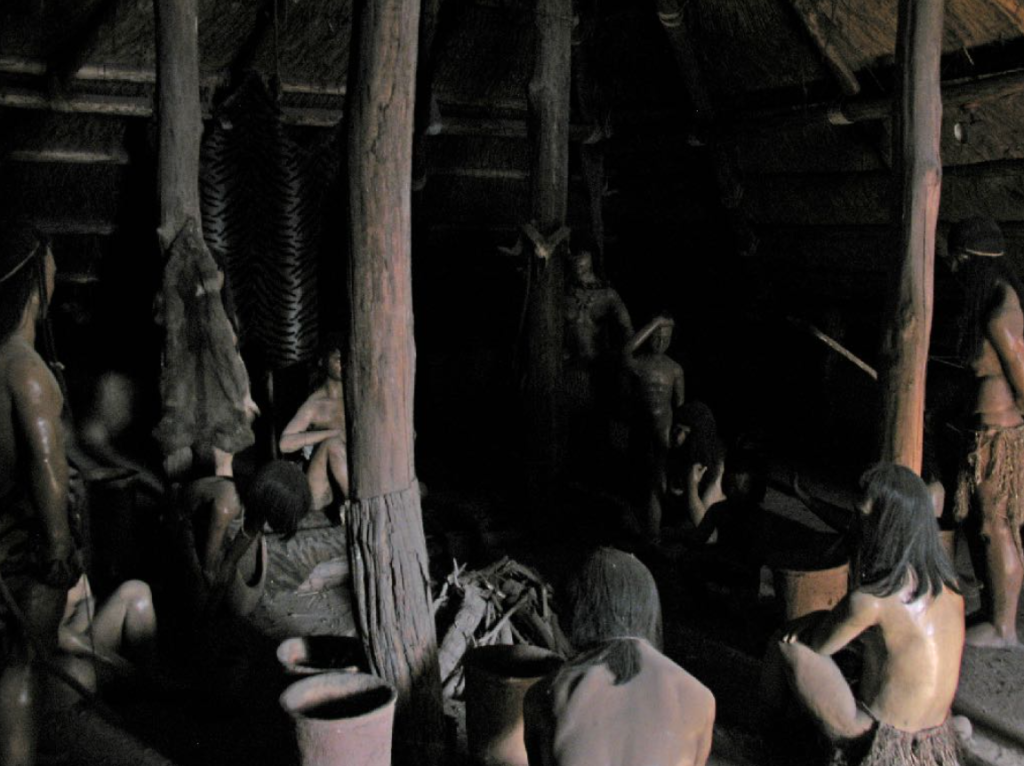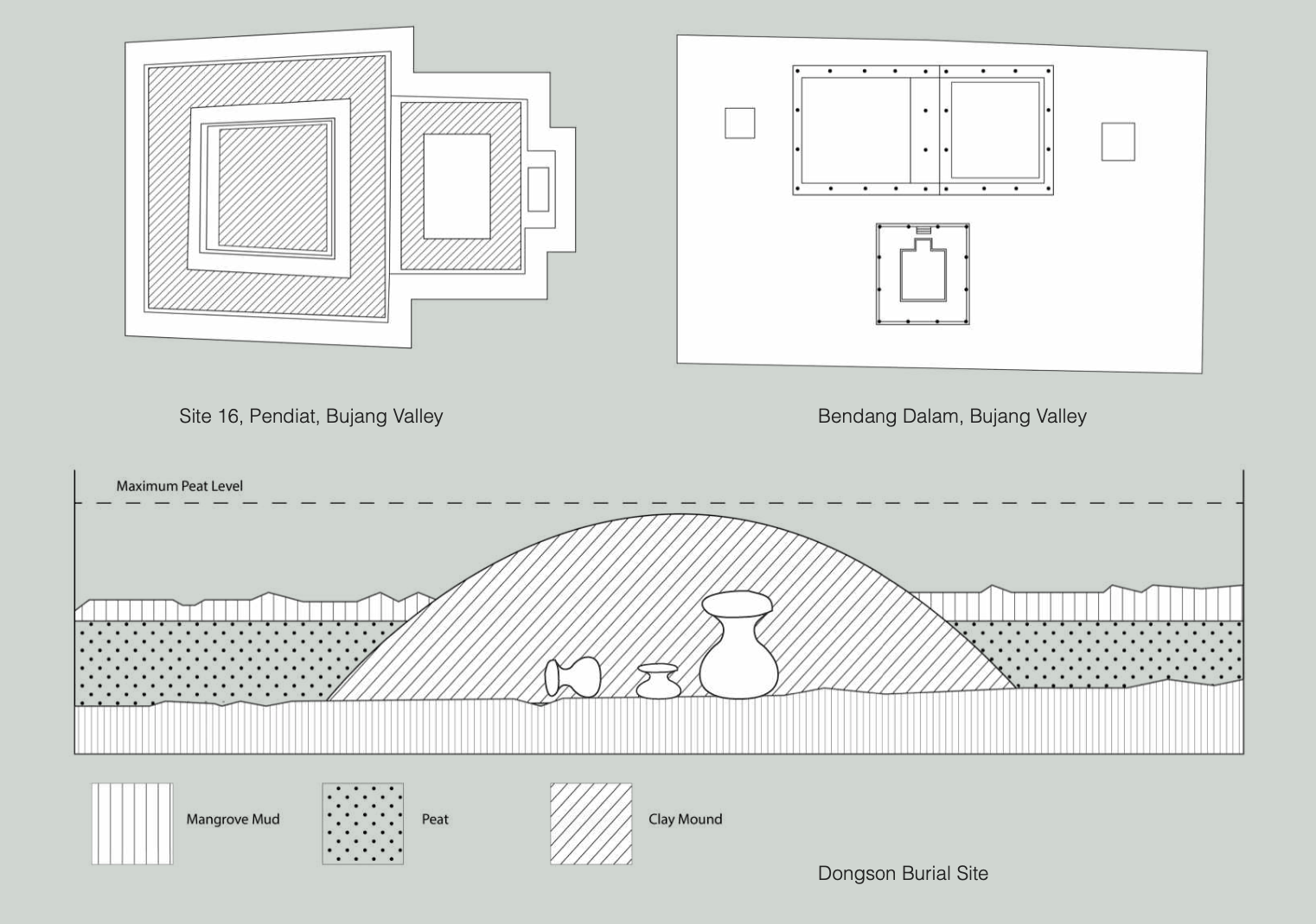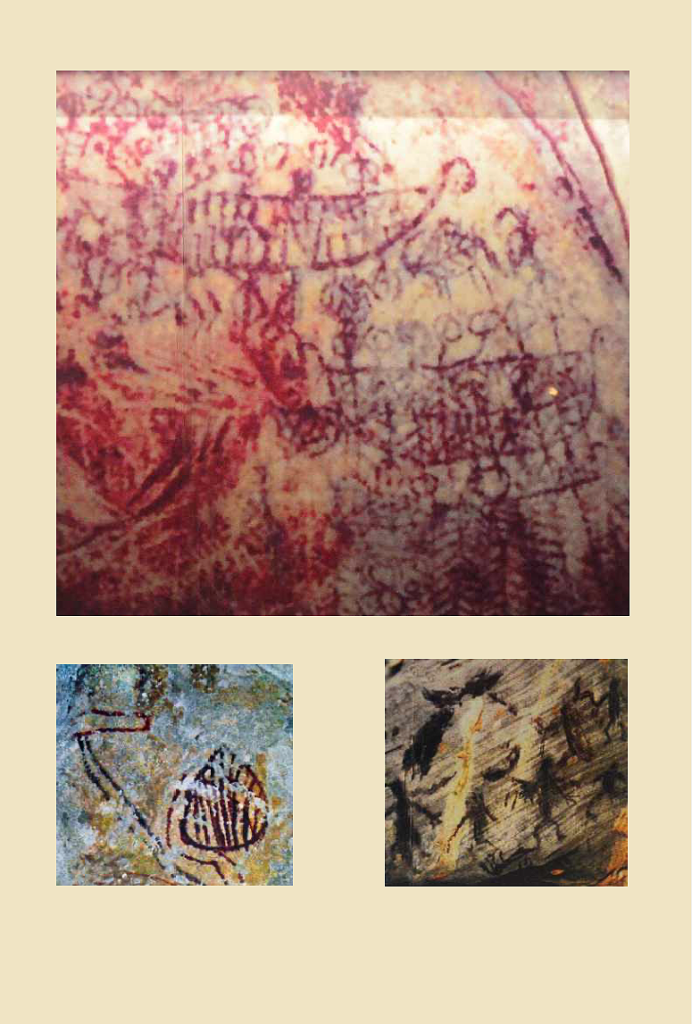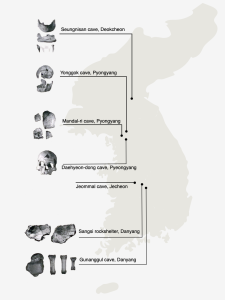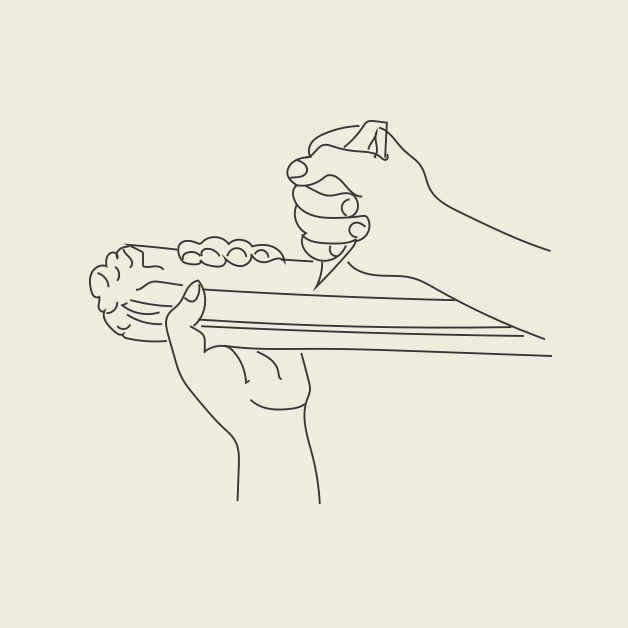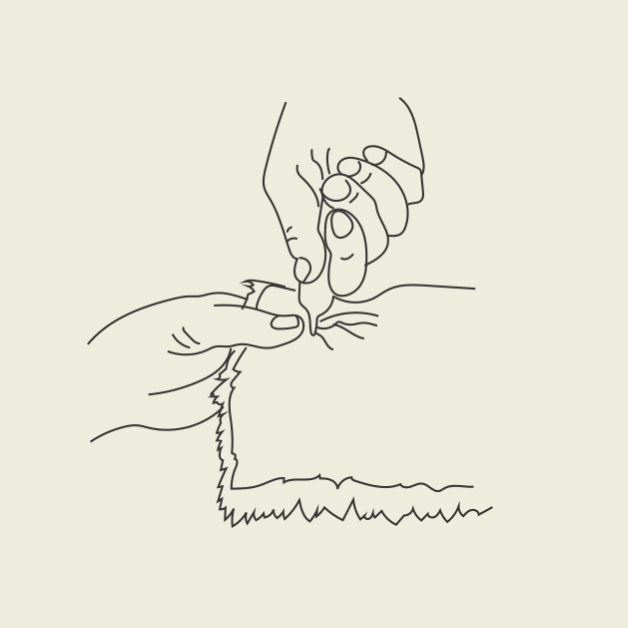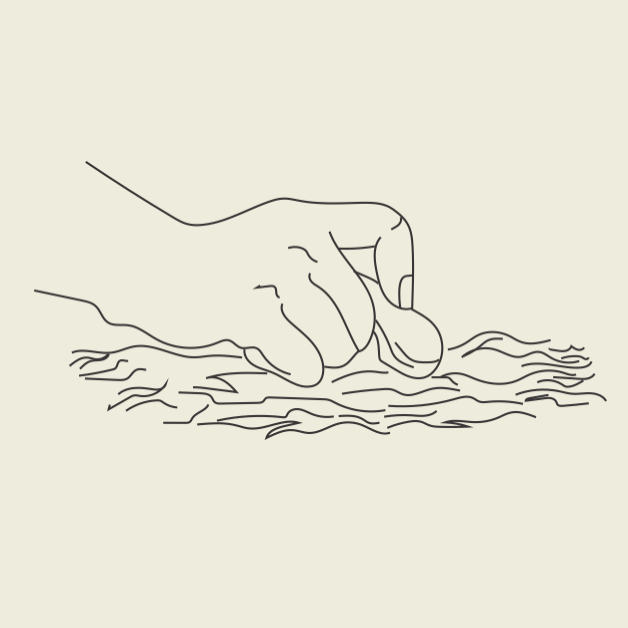Notes, thoughts, ideas on the nature of art & expression
Introduction
This work shall examine the modalities and evolution of art looking to clarify the relationship of abstraction to realism, the use of symbolism in abstraction as a product of spirituality; as well as the modern use of metaphor as a contextual parameter for direct meaning in contemporary art. I hope to draw correlations that will help students and laymen grasp an understanding of the enormous power and heritage found throughout art and its history.
Neolithic Paleolithic
The works considered to fall under Paleolithic periods is circa 32,000-11,000 years ago. Works first marking this time are typically known as cave paintings this also applied to objects found in or nearby these caves. Such as bone or antler typically carved with patterns or what are considered to be decorative motifs. I have looked to this period many times for many reasons, mostly to examine the first evolution of aesthetics and to ask some of the following questions along with others:
- 1. What drove the need to create objects painted or carved?
- 2. Was there rudimentary language through symbols that were understood by most at the time?
By looking at the need for early man to document day-to-day existence, we see the emergence of ritual as the first manifestation of expression. These first manifestations were based upon the relationship of man to his natural environment. It becomes easier to see modern civilization’s relationship to this early understanding and subsequently understand its reciprocal admiration of this period. It is from these first early observations that we may begin to answer some of the questions listed above. I believe that the inhabitants living in the area of this time including Mesolithic, Neolithic with of course some variations, saw the use of marking there tools with symbols and inscriptions as a way of tribal identification or territorial marker. The symbols inscribed on tools found nearby these areas would signify to others that the territory had been marked. And by using the same inscriptions throughout the caves or objects let neighboring tribes see the extent of area or territory covered.
Once purpose was established in the marking of objects I believe associations of those markings started to acquire meaning for the individuals making the objects and the representation of how the markings where made also began to take on layers of meaning. What is in man that he feels the need to create? We first need to look to nature’s role in relation to man in this time frame so that we may ascertain meaning if any, and begin to identify key elements those relationships appear to manifest. As with some artist today who explore the relationship of nature to materials and concept through art. It is my belief that individuals living in Paleolithic times began a similar relationship, though there are those who feel it as being unconscious to them at the time but in essence a spiritual relationship to nature. The same experience today that we now reserve for devote religious individuals. If these first markings began with spiritual relations to nature, it follows that the evolution of this process would not stray to far from its original intent. It seems logical that over time individual members (shaman) or (artist) were given the task of documenting the tribes identity and daily existence.

Lascaux cave. Paint on limestone, 15,000-13,000 BCE
Other archaeologist and historians such as Joseph Campbell have attributed the paintings to signify initiation rights of younger tribal members into manhood. I think this to deserves consideration having the benefit of studying rituals in present day tribal practice.
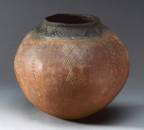



Prehistoric World Art Timeline
Southeast Asia Sites
A number of bronze drums, known as Dongson drums, usually in pairs, were found buried in several sites in Malaysia . These burials remain a mystery as most of them were chance finds with little or no archaeological data . The bronze drums were discovered in Kuala Terengganu, Ulu Tembeling, Kelang and Banting and are believed to have been brought from Northern Vietnam based on similarities in shape and motifs on the drum face between drums found there and those from local sites. The discovery of a pair of these drums at Kampung Sungai Lang in Banting, Selangor gave impetus to a new chapter in gathering data on Dongson drum burials as the site was systematically excavated. The find has since been classified as a symbolic burial for a personage of a high social status in his community. The excavation revealed that the Dongson drums were buried face down on a 2 meter long cengal hardwood plank believed to have been taken from an old boat. The whole of the drums were buried in earth piled up as a mound measuring about 5 meters at ground level and 1 meter at its peak. Then clay pots were also recovered, surrounding the drums. These were believed to have held food and water, while glass beads were also found scattered among the pots.
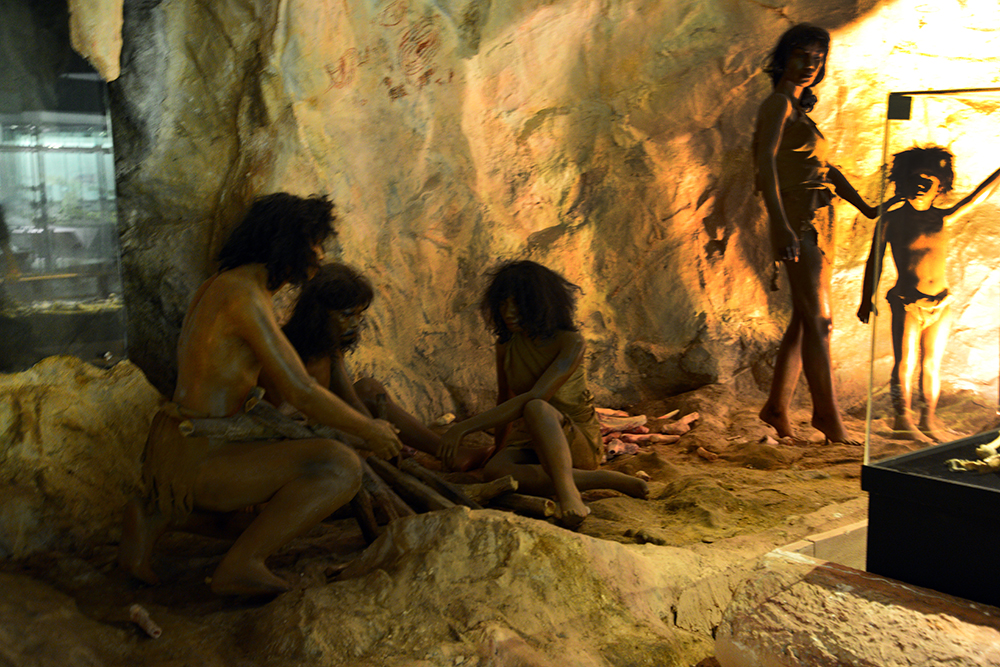


XINLE SITE MUSEUM
The Xinle Site Museum is located in the northern part of the Huang- gu District of Shenyang City, the museum has an exhibition hall for displaying many relics, while the northern area is the actual archaeological site. The site has revealed objects from the Neolithic period, reproduced together with a simulated lifestyle of people living at that time. The archaeological site has uncovered objects belonging to a period roughly 7,200 years ago. On exhibit are 10 habitats display- ing how the original occupants might have lived. Most of the dwellings are half underground and display a unique and creative view of construction.

Site Living Exhibits
Pottery & Tools Found On Site Liaoning Shenyang
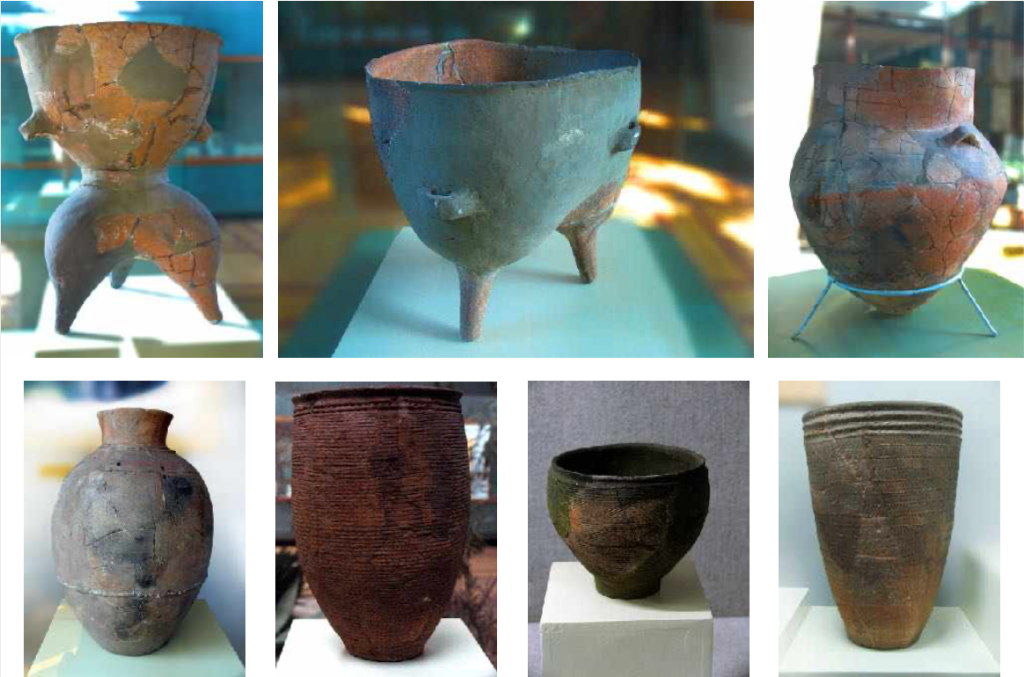

Prehistoric Malaysia BUJANG VALLEY
Bujang Valley, the site of an early Malay Kingdom is located be- tween the south of Kedah and Penang island. was established by Raja Merong Mahawangsa in the 4th century A.D. The Bujang Valley o thought to be the earliest kingdom in Malaysia, and it was also famous as an international trading centre between the 4th and 14th centuries A.D. It covered an area of 140 square kilometers based on the discovery of the remains of a candi (temple) on Bukit Charas to the north, and an inscription found on a rock in Bukit Mertajam to the south. the Bujang Valley is known by a variety of names. such as Kidaram by Indian writers, Kataha or Kalah by Arab seafarers. while the Chinese writers referred to it as Chiehcha. The terrain and landscape of the Bujang Valley proved to be an attraction to traders and seafarers. Gunung Jerai served as a beacon and landmark to voyagers from the Indian Ocean. The waterfall at the foot of Gunung Jerai was a popular attraction to Indian traders. The Bujang Volley also provided abundance food and water resources for voyagers.
More than 60 candis (temples) and other building structure have been dis- covered in the Buiang Valley. Candis are generally stupes while the Hindu candi comprised of a ‘mandapo’ (open hall) and the ‘vimano’ (vestibule). Materials used in the construction of these structures included chiseled granite blocks, laterite, cloy bricks and river pebbles. There were several phases in the development of trade in the Bujong Valley. It is believed that trade began around Kompung Sungai Emos and Seberang Perai in the 4th century A.D .. and later expanded to Pengkaton Bujang don Merbok around the 9th or 10th century A.D., until its decline in the 14th century. Trade artifacts recovered in the Bujong Volley include beads from the Middle East, ceramics from the Tong and Song Dynasties of Chino, coins from the Abyssinian era, gold and brass ornaments among others
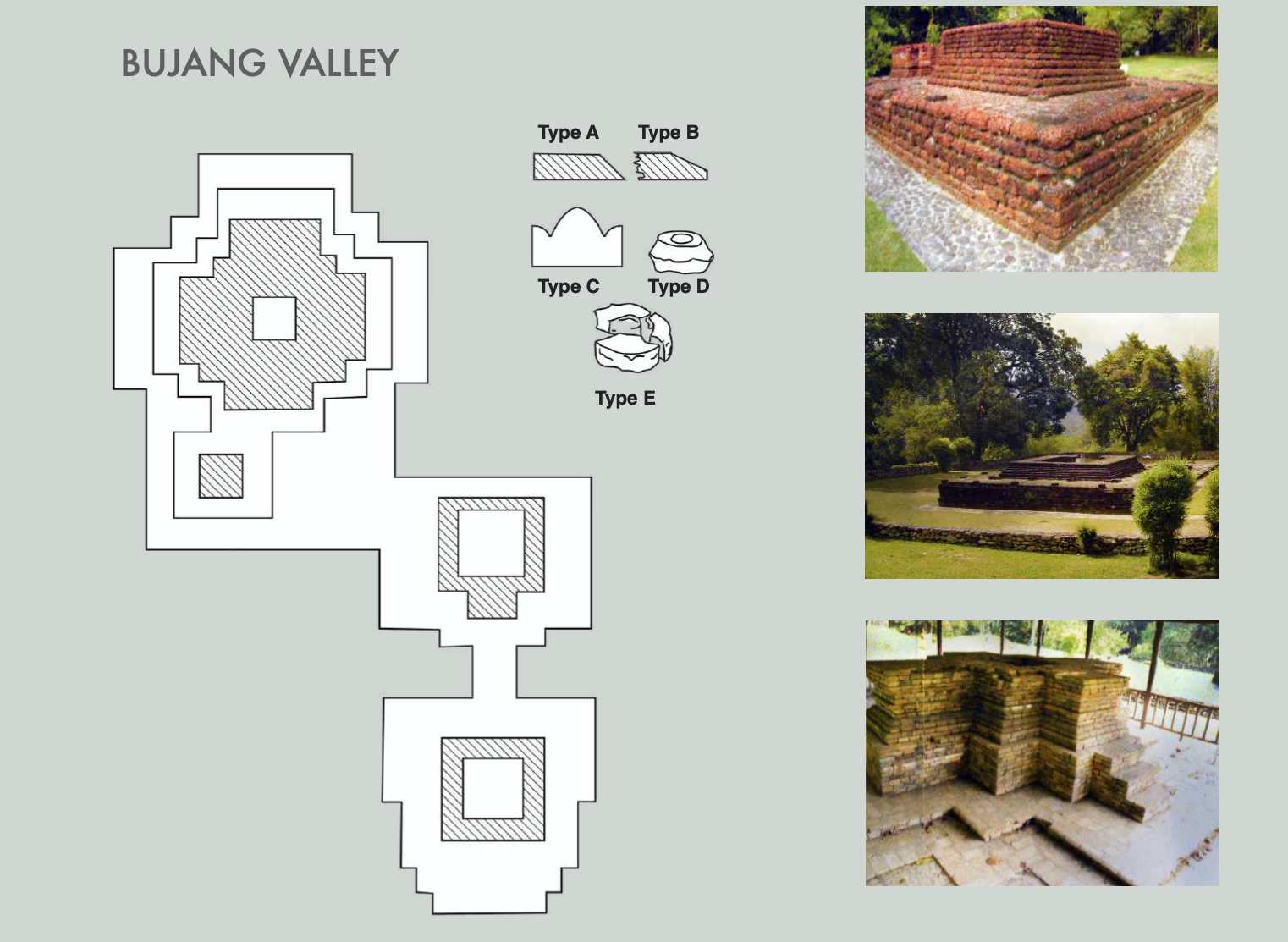
PERAK MAN
Perak man is considered to be the most significant discovery of the remains of a modern man (Homo sapiens) ever discov- ered in Malaysia, both because of its an- tiquity of over 10,000 year’s and also be- cause of its most complete anatomical state.
He was buried in a crouched position along with several funerary goods which included some stone tools and food such as shells and meal of a variety of ani- mals. Perak Man is a male born with a congenital birth defect identified as Bra- chymesophalangia Type A2.
He is believed to have been buried with full customary honors as if he was an es- teemed member of his community. He was between 40-45 years old when he died. Perak Man has been classified as a predecessor to the Australo-Melanesoid race found around the Pacific Islands and Australia.
Clearly, the discovery of Perak Man is not only significant in tracing the human prolif- eration of Southeast Asia and the Pacific
but also in tracing the origins of man in Malaysia, especially in relation to the an- cestors of the Orang Asli in Peninsular Malaysia.
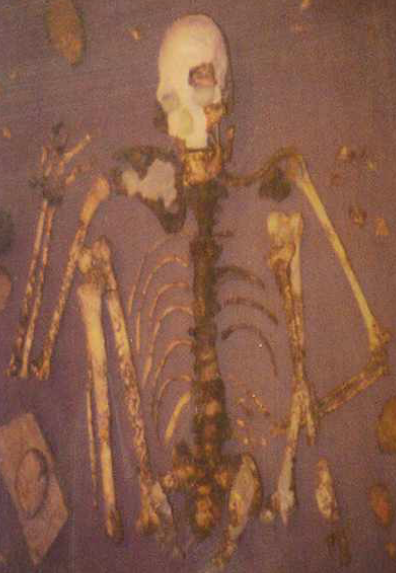

CAVE PAINTINGS
Cave paintings are a universal occurrence. The prehistoric people of Malaysia, especially the ancestors of Orang Asli and the indigenous tribes of Sabah and Sarawak have left behind cove paintings as the means of communicating, and documenting their daily activities, life experiences and rituals.
The earliest cave paintings are believed to have been produced with haematite and found in Guo Tambun in Perak, and Guo Kain Hitam in Niah, Sarawak. The painting in Guo Tambun features game animals such as deer and dugong, besides some geometric designs and palm prints.
Meanwhile, the paintings in Guo Kain Hitam, feature symbolic boats related to the practice of interring the body of a de- ceased person in a boat placed on the cave floor. The painting is a symbolic depiction of the journey of the soul into the after- life. Other cave paintings were done using a mixture of charcoal and tree sap, and such paintings are widely distributed through- out Malaysia.
Among the more interesting of these are found in Ulu Kelantan, which show the gathering of people and features gender differentiation. Meanwhile, the paintings found in Guo Kelawar in Sungai Siput, Perak depict some animals and geometric designs. The cave paintings in Guo Badak in Lenggong, Perak, records the experience of the Orang Asli communities there during the colonial era, showing British officers mounted on horses and also drawings of motorcars.

HOABINHIAN/EPI-PALEOLITHIC
Epi-Paleolithic or Hoabinhian Age is said to begin around 12,000 to 5000 years ago. Numerous archaeological evidence around this age have been found in the interior of Malaysia, particularly in lime stone caves flats, and coastal areas. This situation is believed to hove originated from the melting of ice during the Lost Pleistocene Age when man was forced to retreat and migrate to the mainland. Some researchers called this age the Epi-Paleolithic or Hoabinhian Age. due to the Late Pleistocene lifestyle of man at that time which was nomadic, gathered plant resources, hunting animals and catching fish.
However. there of incipient agricultural activities and the used of pottery of this period. Stone tools of this age are characterized through river grass flaked on one surface (unofficial) or both surface techniques of making stone tools during this age spread far throughout Southeast Asia, especially Vietnam, Cambodia North Eastern port of Sumatra.
The people of this age buried their dead in a flexed position with knees bent to the chin. There is also evidence that showed the funerary rituals such as covering the corpse with application of red ochre and hematite.
GUA CHA
Gua Cha in Ulu Kelantan is one of the most important sites for Prehistoric Malaysia because 45 human skeletons were found here. There is a theory that the people who lived in Gua Cha were the ancestors of the Orang and the ancient Melanesian. Gua Cha is also known as Gua Menteri, a rock shelter measuring 120 meters long and 20 meters wide. From the archaeological perspective, Gua Cha is one of the actively excavated sites in Peninsular Malaysia besides Lenggong Valley in Perak and Gua Niah in Sarawak. According to researchers, there are more than 30 signs of human inhabitance during the Hoabinhian and Neo- lithic periods in this cave along with discoveries of potteries of various shapes and interesting designs. The food remains found at the site also proved that the community then did not only hunt small animals but larger animals such as seladang (gaur) and wild boars. Studies have also showed that this cave was inhabited by the Hoabinhian people 10,000 years ago, followed by the Neolithic community about 4, 000 years after that.
Researchers such as H. D. Noone (1936), G. de G. Sieveking (1954), M. W.F. Tweedie (1954) and Adi Haji Taha (1979) have put forward various interpretations including the human migration wave during the Hoabinhian and Neolithic periods. The research carried out by Sieveking uncovered 37 skeletons, 14 of which were human remains from the Hoabinhian! Epi- palaeolithic era buried in a flexed position; while the other 23 skeletons were in an extended position accompanied by potteries, ornaments, stone tools, and food remains. The displays here are evidence of the early settlements that reflect the activities of the communities during that time. In general, Gua Cha was an important stopover and place of settlement during Prehistoric times due to its close proximity to the river which was the main route of the communities. Thus, the Neolithic community who lived in the 6 surrounding areas has specifically chosen the cave as their burial grounds.
NEOLITHIC AGE
Earth that are suitable to be made into implements. Neolithic communities also practiced rudimentary farming such as planting of crops, domesticated and reared animal. and may also have been involved in barter trading. They put on at- tires specially made from the bark of trees. The development, experience and daily practices that they underwent were recorded through drawings on the wall of limestone caves.
Approximately 4000 years ago, communi- ties of this region experienced a great change and a new civilization in their life. This was achieved through a dynamic technological advancement in producing stone tools, pottery, and the use and con- trol of fire in their life. This age is known as the Neolithic Age or the New Stone Age. This age is characterized through the existence of stone tools such as the adze and axe that were grinded into vari- ous shapes, as well as the utilization of personal adornment accessories and pot- tery in an extensive manner. They were also said to possess the skills and knowl- edge regarding the types of stones and
Prehistoric Korea
The early ancestors of modern humans, who walked up-right, lived in Africa around 4.4 million years ago. Later, other ancestral hominids, such as Australopithecus, Homo habilis, Homo erectus, and Homo sapiens, appeared and then became extinct. The evolution of these hominids eventually led the emergence of Anatomically Modern Humans around 60,000~50,000 years ago. In the Korean Peninsula, only the fossil remains of Homo sapiens have been identified thus far.
Hunting and Gathering
The Paleolitic communities of the Korean Peninsula were able to obtain various resources through hunting. Plants were also an important source of food. The stone tools of the Early Paleolithic Age were mainly made of quartzite and used during hunting and gathering. They served various functions, such as stabbing, cutting, digging, scrapping and grinding.
The Development of Tools
Stone tools became smaller and more refined with the passage of time. Various types of stone tools which served specific functions also emerged. New types of fine-grained stone, such as hornfels, shale and obsidian, were used to make blades from approximately 40,000 years ago, and micro-blades.
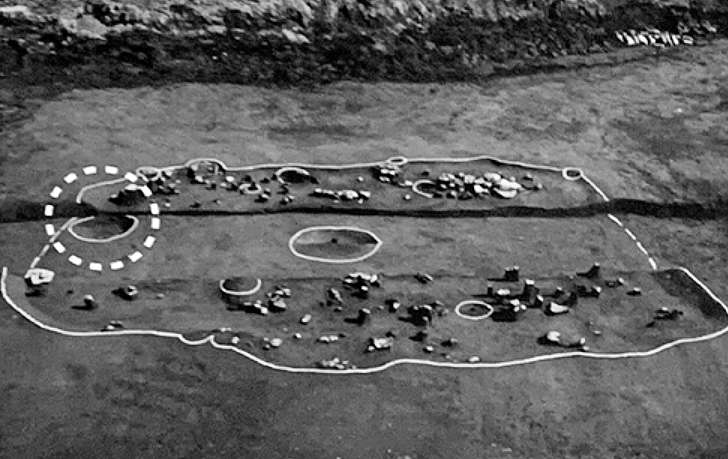
Paleolithic people used stone, wood, animal bone and horn to make the tools required by their daily activities.
Of these Paleolithic tools, it is generally those made of stone that have been preserved. However, tools made of bone have also been recovered from archaeological con-texts, albeit in rare circumstances.
Natural Stone and Chipped Stone Tools
What is the difference between a naturally chipped stone and an artificially chipped stone tool? Chipped stone tools have a regular shape and contain concentrated traces of deliberate alteration. A preference for certain stone types can also be observed in the case of stone tools. The manufacturing process of chipped stone tools can be inferred by refitting stone cores and flakes.
Human Evolution and the Korean Peninsula
The early ancestors of modern humans, who walked up-right, lived in Africa around 4.4 million years ago. Later, other ancestral hominids, such as Australopithecus, Homo Habilis, Homo Erectus, and Homo sapiens, appeared and then became extinct. The evolution of these hominids eventually led the emergence of Anatomically Modern Humans around 60,000~50,000 years ago. In the Korean Peninsula, only the fossil remains of Homo sapiens have been identified thus far.
The Korean Peninsula around 8,000 BCE
The present-day topography, fauna and flora of the Korean Peninsula gradually began to be established from around 10,000 years ago, as the climate became warmer. Small and nimble animals, such as wild pigs and deer, made an appearance. The bow and arrow was used to hunt such animals, and pottery was used to effectively transport store and cook various types of food resources.
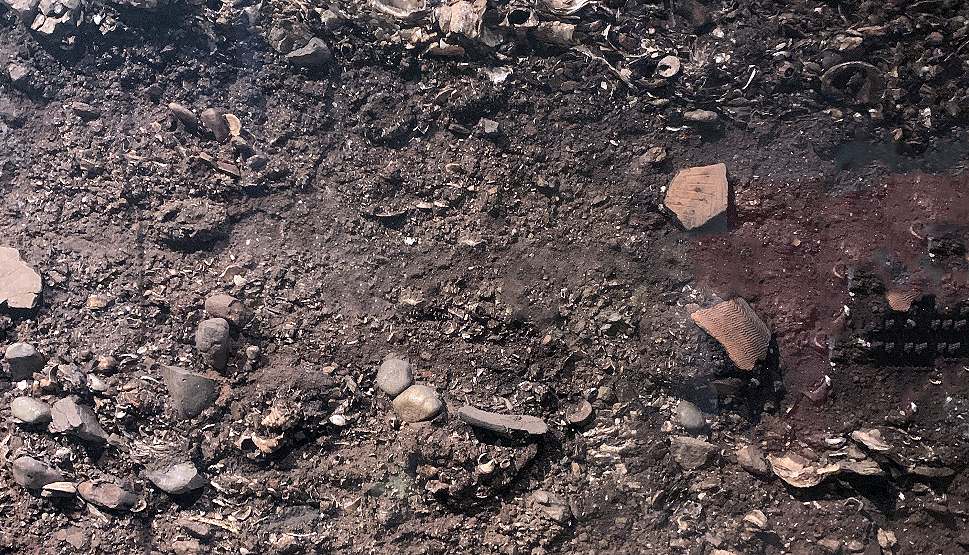
Objects found in Macau





Collection of raw materials a number of cobbles collected from a local riverbed. The stones are struck to obtain the primary flakes.
Manufacture of the preform for the rings. The primary flake was struck to form an oval shaped blank; then the blank was polished by a polishing tool to shape the preform.
Tubular drilling: by using a rotating mechanism the preform was then perforated, separating the ring from the inner disc.
Refining bracelets, or siting an opening in the case of earrings.




Discovered in the nearby area of the rotary part of the axia were inner discs and semi completed rings.
It is astonishing that, more than 4000 years ago during the Late Neolithic Age. the inhabitants of Hac Sa were able to perforate with some ease objects in quartz and rock crystal, in a time when metal utensils had still not been adopted in Macao.
A stone object in the shape of a lemon that was discovered in 1995 during excavation, shed light on the solution to this thousand year old mystery
Recent studies have shown that this stone lemon shaped object, is the rotary part of the axis of a rotary machine.
Emergence of Pottery
Pottery was first invented around 10,000 years ago when humans came to recognize the chemical changes that took place when clay was fired. It made new methods of cooking possible and this led to a broader range of cooking ingredients. The storage and transportation of these ingredients also became easier. The result of this was greater stability in terms of diet, and this led to a more. sedentary lifestyle.
The earliest type of pottery, dating to 8,000 BCE, was excavated in Jeju Island. Pottery with appliqué decoration and pottery with imprinted design were used in the Eastern and Southern coastal regions from 6,000 BCE, and comb-pattern pottery came into use in the Midwestern region from around 5,000 BCE. Pottery from all regions of the Korean Peninsula evidenced common changes, such as the simplification of patterns and the reduction of the decorated surface area.
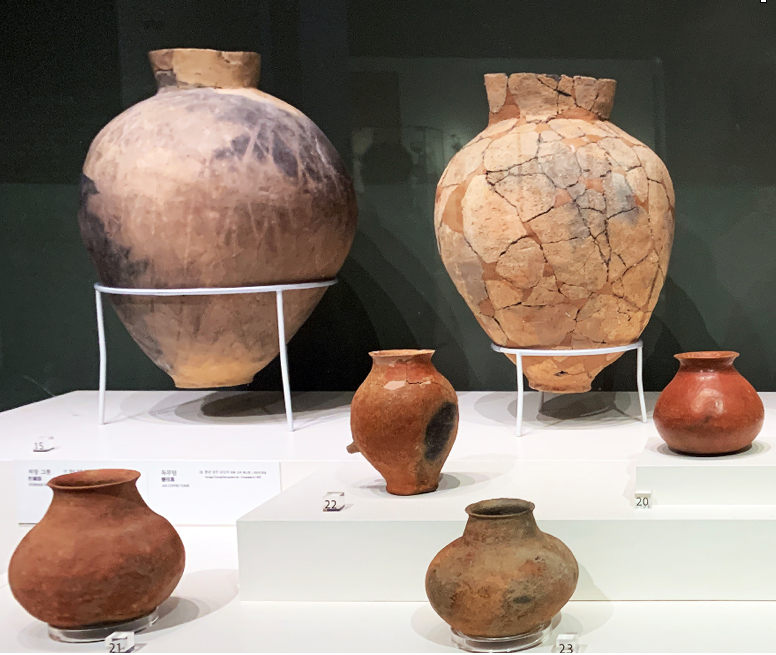
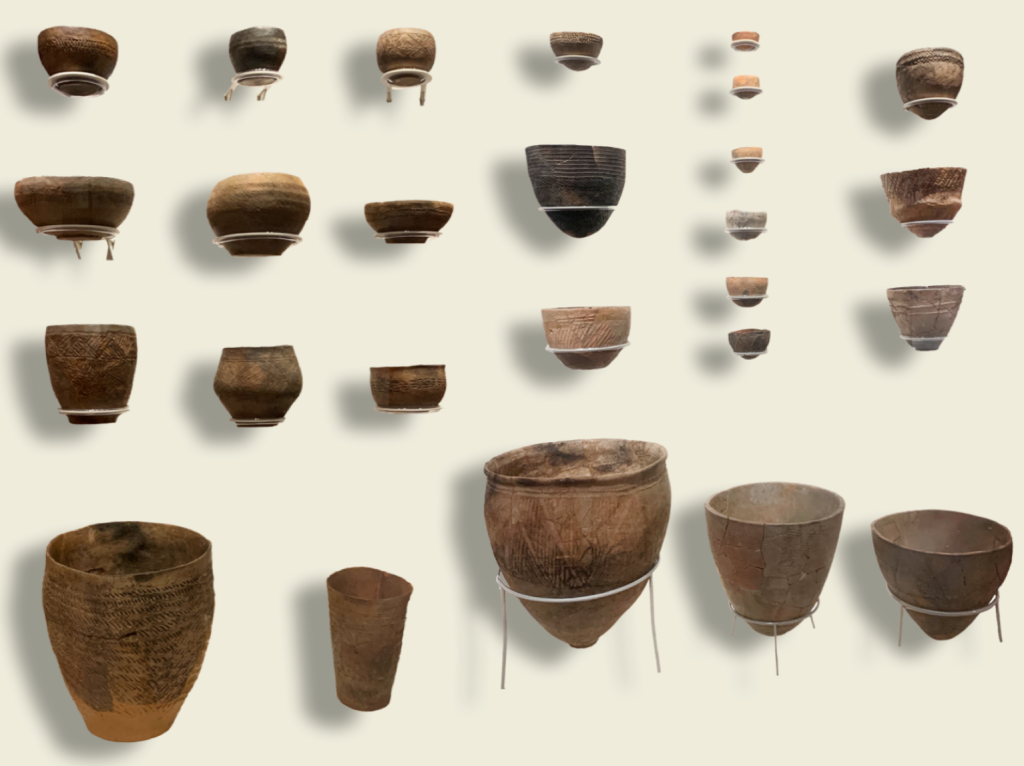
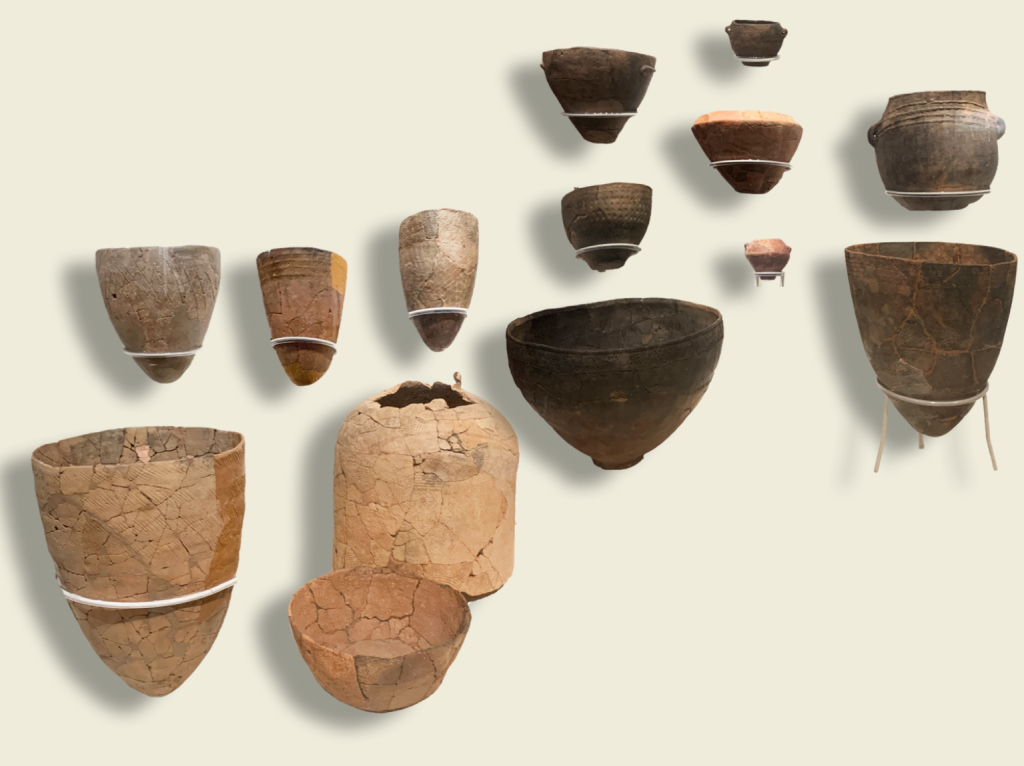
Burials
Burials are an important source of information which can provide insight into Neolithic perceptions of death and the afterlife. Various types of burials were used in the Neolithic Age. The dead were buried in pits and caves, or their bones only were interred into pottery vessels or pits. Neolithic people adorned the dead with ornaments and put placed items necessary for the afterlife within the burials.
Ornaments and Art
Neolithic individuals began to adorn their bodies with bracelets, necklaces and earrings as their lives became more settled in this period. They also made art objects which depicted human faces, female forms, animals and ships. These ornaments and art objects were not only meant to express beauty, but also served religious or ritual purposes, or acted as symbols of social identity or status.


